Iron Oxides Nanoparticles as Components of Ferroptosis-Inducing Systems: Screening of Potential Candidates
Abstract
1. Introduction
2. Materials and Methods
2.1. Chemicals
2.2. Preparation of Fe3O4
2.3. Preparation of γ-Fe2O3
2.4. Preparation of δ-FeOOH
2.5. Preparation of 5Fe2O3·9H2O
2.6. Preparation of α-FeOOH-Fe2+
2.7. Characterization
3. Results and Discussion
3.1. Microstructure of Iron Nanoparticles
3.2. Magnetic Characteristics of Samples
3.3. Textural Characteristics
3.4. Iron Ions Release
4. Conclusions
Supplementary Materials
Author Contributions
Funding
Institutional Review Board Statement
Informed Consent Statement
Data Availability Statement
Conflicts of Interest
References
- Shams, M.; Owczarczak, B.; Manderscheid-Kern, P.; Bellnier, D.A.; Gollnick, S.O. Development of photodynamic therapy regimens that control primary tumor growth and inhibit secondary disease. Cancer Immunol. Immunother. 2014, 64, 287–297. [Google Scholar] [CrossRef] [PubMed]
- Efimova, I.; Catanzaro, E.; Van der Meeren, L.; Turubanova, V.D.; Hammad, H.; Mishchenko, T.A.; Vedunova, M.V.; Fimognari, C.; Bachert, C.; Coppieters, F.; et al. Vaccination with early ferroptotic cancer cells induces efficient antitumor immunity. J. Immunother. Cancer. 2020, 8, e001369. [Google Scholar] [CrossRef] [PubMed]
- Szatrowski, T.P.; Nathan, C.F. Production of large amounts of hydrogen peroxide by human tumor cells. Cancer Res. 1991, 51, 794–798. [Google Scholar] [PubMed]
- Dan, Q.; Hu, D.; Ge, Y.; Zhang, S.; Li, S.; Gao, D.; Sheng, Z. Ultrasmall theranostic nanozymes to modulate tumor hypoxia for augmenting photodynamic therapy and radiotherapy. Biomater. Sci. 2020, 107, 2411–2502. [Google Scholar] [CrossRef]
- El-Fiqi, A.; Kim, H.-W. Iron ions-releasing mesoporous bioactive glass ultrasmall nanoparticles designed as ferroptosis-based bone cancer nanotherapeutics: Ultrasonic-coupled sol–gel synthesis, properties and iron ions release. Mater. Lett. 2021, 294, 129759. [Google Scholar] [CrossRef]
- Li, J.; Xiong, Z.; Yu, Y.; Wang, X.; Zhou, H.; Huang, B.; Lai, B. Efficient degradation of carbamazepine by electro-Fenton system without any extra oxidant in the presence of molybdate: The role of slow release of iron ions. Appl. Catal. B Environ. 2021, 298, 120506. [Google Scholar] [CrossRef]
- Yang, Y.; Zuo, S.; Li, L.; Kuang, X.; Li, J.; Sun, B.; Sun, J. Iron-doxorubicin prodrug loaded liposome nanogenerator programs multimodal ferroptosis for efficient cancer therapy. Asian J. Pharm. Sci. 2021, 16, 784–793. [Google Scholar] [CrossRef]
- Shen, Z.; Song, J.; Yung, B.C.; Zhou, Z.; Wu, A.; Chen, X. Emerging strategies of cancer therapy based on ferroptosis. Adv. Mater. 2018, 30, 1704007. [Google Scholar] [CrossRef]
- Meng, X.; Deng, J.; Liu, F.; Guo, T.; Liu, M.; Dai, P.; Zhao, Y. Triggered all-active metal organic framework: Ferroptosis machinery contributes to the apoptotic photodynamic antitumor therapy. Nano Lett. 2019, 19, 7866–7876. [Google Scholar] [CrossRef]
- Shan, X.; Li, S.; Sun, B.; Chen, Q.; Sun, J.; He, Z.; Luo, C. Ferroptosis-driven nanotherapeutics for cancer treatment. J. Control Release 2020, 319, 322–332. [Google Scholar] [CrossRef]
- An, Q.; Sun, C.; Li, D.; Xu, K.; Guo, J.; Wang, C. Peroxidase-like activity of Fe3O4@carbon nanoparticles enhances ascorbic acidinduced oxidative stress and selective damage to PC-3 prostate cancer cells. ACS Appl. Mater. Interfaces 2013, 5, 13248–13257. [Google Scholar] [CrossRef]
- Huo, M.; Wang, L.; Chen, Y.; Shi, J. Tumor-selective catalytic nanomedicine by nanocatalyst delivery. Nat. Commun. 2017, 8, 357. [Google Scholar] [CrossRef]
- Zheng, D.-W.; Lei, Q.; Zhu, J.-Y.; Fan, J.-X.; Li, C.-X.; Li, C.; Xu, Z.; Cheng, S.-X.; Zhang, X.-Z. Switching apoptosis to ferroptosis: Metal–organic network for high-efficiency anticancer therapy. Nano Lett. 2016, 17, 284–291. [Google Scholar] [CrossRef]
- Liang, Y.; Zhang, L.; Peng, C.; Zhang, S.; Chen, S.; Qian, X.; Luo, W.; Dan, Q.; Ren, Y.; Li, Y.; et al. Tumor microenvironments self-activated nanoscale metal-organic frameworks for ferroptosis based cancer chemodynamic/photothermal/chemo therapy. Acta Pharm. Sin. B 2021, 11, 3231–3243. [Google Scholar] [CrossRef]
- Minotti, G.; Aust, S.D. The role of iron in the initiation of lipid peroxidation. Chem. Phys. Lipids 1987, 44, 191–208. [Google Scholar] [CrossRef]
- He, Y.-J.; Liu, X.-Y.; Xing, L.; Wan, X.; Chang, X.; Jiang, H.-L. Fenton reaction-independent ferroptosis therapy via Glutathione and iron redox couple sequentially triggered lipid peroxide generator. Biomaterials 2020, 241, 119911. [Google Scholar] [CrossRef]
- Hah, H.Y.; Gray, S.; Johnson, C.E.; Johnson, J.A.; Kolesnichenko, V.; Kucheryavy, P.; Goloverda, G. Mössbauer spectroscopy of superparamagnetic Fe3O4 nanoparticles. J. Magn. Magn. Mater. J. 2021, 539, 168382. [Google Scholar] [CrossRef]
- Tuutijärvi, T.; Lu, J.; Sillanpää, M.; Chen, G. As(V) adsorption on maghemite nanoparticles. J. Hazard. Mater. 2009, 166, 1415–1420. [Google Scholar] [CrossRef]
- Faria, M.C.S.; Rosemberg, R.S.; Bomfeti, C.A.; Monteiro, D.S.; Barbosa, F.; Oliveira, L.C.A.; Rodrigues, J.L. Arsenic removal from contaminated water by ultrafine δ-FeOOH adsorbents. Chem. Eng. J. 2014, 237, 47–54. [Google Scholar] [CrossRef]
- Patrat, G.; de Bergevin, F.; Pernet, M.; Joubert, J.C. Structure locale de δ-FeOOH. Acta. Crystallogr. B. Struct. 1983, 39, 165–170. [Google Scholar] [CrossRef]
- Eusterhues, K.; Rennert, T.; Knicker, H.; Kögel-Knabner, I.; Totsche, K.U.; Schwertmann, U. Fractionation of organic matter due to reaction with ferrihydrite: Coprecipitation versus adsorption. Environ. Sci. Technol. 2011, 45, 527–533. [Google Scholar] [CrossRef] [PubMed]
- Lv, J.; Zhang, S.; Wang, S.; Luo, L.; Cao, D.; Christie, P. Molecular-scale investigation with ESI-FT-ICR-MS on fractionation of dissolved organic matter induced by adsorption on iron oxyhydroxides. Envi Environ. Sci. Technol. 2016, 50, 2328–2336. [Google Scholar] [CrossRef] [PubMed]
- Tipping, E. The adsorption of aquatic humic substances by iron oxides. Geochim. Cosmochim. Acta. 1981, 45, 191–199. [Google Scholar] [CrossRef]
- Elmore, W.C. Ferromagnetic colloid for studying magnetic structures. Phys. Rev. 1938, 54, 309–310. [Google Scholar] [CrossRef]
- Pinto, I.S.X.; Pacheco, P.H.V.V.; Coelho, J.V.; Lorençon, E.; Ardisson, J.D.; Fabris, J.D.; Pereira, M.C. Nanostructured δ-FeOOH: An efficient Fenton-like catalyst for the oxidation of organics in water. Appl. Catal. B: Environ. 2012, 119–120, 175–182. [Google Scholar] [CrossRef]
- Zhang, P.; Liu, A.; Huang, P.; Min, L.; Sun, H. Sorption and molecular fractionation of biochar-derived dissolved organic matter on ferrihydrite. J. Hazard. Mater. 2020, 392, 122260. [Google Scholar] [CrossRef]
- Lowry, G.V.; Johnson, K.M. Congener-specific dechlorination of dissolved PCBs by microscale and nanoscale zerovalent iron in a water/methanol solution. Environ. Sci. Technol. 2004, 38, 5208–5216. [Google Scholar] [CrossRef]
- Toby, B.H. R factors in Rietveld analysis: How good is good enough? Powder Diffr. 2006, 21, 67–70. [Google Scholar] [CrossRef]
- Gorski, C.A.; Scherer, M.M. Determination of nanoparticulate magnetite stoichiometry by Mossbauer spectroscopy, acid dissolution, and powder X-ray diffraction: A critical review. Am. Mineral. 2010, 95, 1017–1026. [Google Scholar] [CrossRef]
- Yurkov, G.Y.; Shashkeev, K.A.; Kondrashov, S.V.; Popkov, O.V.; Shcherbakova, G.I.; Zhigalov, D.V.; Koksharov, Y.A. Synthesis and magnetic properties of cobalt ferrite nanoparticles in polycarbosilane ceramic matrix. J. Alloys Compd. 2016, 686, 421–430. [Google Scholar] [CrossRef]
- Pankratov, D.A.; Anuchina, M.M.; Spiridonov, F.M.; Krivtsov, G.G. Fe3—δO4 Nanoparticles synthesized in the presence of natural polyelectrolytes. Crystallogr. Rep. 2020, 65, 393–397. [Google Scholar] [CrossRef]
- Pankratov, D.A.; Anuchina, M.M. Nature-inspired synthesis of magnetic non-stoichiometric Fe3O4 nanoparticles by oxidative in situ method in a humic medium. Mater. Chem. Phys. 2019, 231, 216–224. [Google Scholar] [CrossRef]
- Oh, S.J.; Cook, D.C.; Townsend, H.E. Characterization of iron oxides commonly formed as corrosion products on steel. Hyperfine Interact 1998, 112, 59–66. [Google Scholar] [CrossRef]
- Polyakov, A.Y.; Goldt, A.E.; Sorkina, T.A.; Perminova, I.V.; Pankratov, D.A.; Goodilin, E.A.; Tretyakov, Y.D. Constrained growth of anisotropic magnetic δ-FeOOH nanoparticles in the presence of humic substances. CrystEngComm 2012, 14, 8097. [Google Scholar] [CrossRef]
- Polyakov, A.Y.; Sorkina, T.A.; Goldt, A.E.; Pankratov, D.A.; Perminova, I.V.; Goodilin, E.A. Mössbauer spectroscopy of frozen solutions as a stepwise control tool in preparation of biocompatible humic-stabilized feroxyhyte nanoparticles. Hyperfine Interact 2013, 219, 113–120. [Google Scholar] [CrossRef]
- Pankratov, D.A. Mössbauer study of oxo derivatives of iron in the Fe2O3-Na2O2 system. Inorg. Mater. 2013, 50, 82–89. [Google Scholar] [CrossRef]
- Valeev, D.; Pankratov, D.; Shoppert, A.; Sokolov, A.; Kasikov, A.; Mikhailova, A.; Salazar-Concha, C.; Rodionov, I. Mechanism and kinetics of iron extraction from high silica boehmite–kaolinite bauxite by hydrochloric acid leaching. Trans. Nonferrous Met. Soc. China 2021, 31, 3128–3149. [Google Scholar] [CrossRef]
- Zimbovskaya, M.M.; Polyakov, A.Y.; Volkov, D.S.; Kulikova, N.A.; Lebedev, V.A.; Pankratov, D.A.; Perminova, I.V. Foliar application of humic-stabilized nanoferrihydrite resulted in an increase in the content of iron in wheat leaves. Agronomy 2020, 10, 1891. [Google Scholar] [CrossRef]
- Cieschi, M.T.; Polyakov, A.Y.; Lebedev, V.A.; Volkov, D.S.; Pankratov, D.A.; Veligzhanin, A.A.; Lucena, J.J. Eco-friendly iron-humic nanofertilizers synthesis for the prevention of iron chlorosis in soybean (Glycine max) grown in calcareous soil. Front. Plant Sci. 2019, 10, 413. [Google Scholar] [CrossRef]
- Rostovshchikova, T.N.; Smirnov, V.V.; Tsodikov, M.V.; Bukhtenko, O.V.; Maksimov, Y.V.; Kiseleva, O.I.; Pankratov, D.A. Catalytic conversions of chloroolefins over iron oxide nanoparticles 1. Isomerization of dichlorobutenes in the presence of iron oxide nanopaticles immobilized on silicas with different structures. Russ. Chem. Bull. 2005, 54, 1418–1424. [Google Scholar] [CrossRef]
- Shoppert, A.; Valeev, D.; Diallo, M.M.; Loginova, I.; Beavogui, M.C.; Rakhmonov, A.; Ovchenkov, Y.; Pankratov, D. High-iron bauxite residue (red mud) valorization using hydrochemical conversion of goethite to magnetite. Materials 2022, 15, 8423. [Google Scholar] [CrossRef] [PubMed]
- Valezi, D.F.; Carneiro, C.E.A.; Costa, A.C.S.; Paesano, A.; Spadotto, J.C.; Solórzano, I.G.; Di Mauro, E. Weak ferromagnetic component in goethite (α-FeOOH) and its relation with microstructural characteristics. Mater. Chem. Phys. 2020, 246, 122851. [Google Scholar] [CrossRef]
- Wang, J.; Sun, J.; Sun, Q.; Chen, Q. One-step hydrothermal process to prepare highly crystalline Fe3O4 nanoparticles with improved magnetic properties. Mater. Res. Bull. 2003, 38, 1113–1118. [Google Scholar] [CrossRef]
- Guivar, J.; Martínez, A.; Anaya, A.; Valladares, L.; Félix, L.; Dominguez, A. Structural and magnetic properties of monophasic maghemite (γ-Fe2O3) nanocrystalline powder. Adv. Nanopart. 2014, 3, 114–121. [Google Scholar] [CrossRef]
- Wu, T.; Li, X.; Fu, Y.; Ding, X.; Li, Z.; Zhu, G.; Fan, J. A highly sensitive and selective fluorescence biosensor for hepatitis C virus DNA detection based on δ-FeOOH and exonuclease III-assisted signal amplification. Talanta 2019, 209, 120550. [Google Scholar] [CrossRef]
- Rani, C.; Tiwari, S.D. Superparamagnetic behavior of antiferromagnetic six lines ferrihydrite nanoparticles. Phys. B Condens. Matter. 2017, 513, 58–61. [Google Scholar] [CrossRef]
- Pono Ponomar, V.P. Thermomagnetic properties of the goethite transformation during high-temperature treatment. Miner. Eng. 2018, 127, 143–152. [Google Scholar] [CrossRef]
- Auffan, M.; Achouak, W.; Rose, J.; Roncato, M.-A.; Chanéac, C.; Waite, D.T.; Bottero, J.-Y. Relation between the redox state of iron-based nanoparticles and their cytotoxicity toward Escherichia coli. Environ. Sci. Technol. 2008, 42, 6730–6735. [Google Scholar] [CrossRef]
- Jambor, J.L.; Dutrizac, J.E. Occurrence and constitution of natural and synthetic ferrihydrite, a widespread iron oxyhydroxide. Chem. Rev. 1998, 98, 2549–2586. [Google Scholar] [CrossRef]
- Gaboriaud, F.; Ehrhardt, J.-J. Effects of different crystal faces on the surface charge of colloidal goethite (α-FeOOH) particles: An experimental and modeling study. Geochim. Cosmochim. Acta 2003, 67, 967–983. [Google Scholar] [CrossRef]
- Ma, P.A.; Xiao, H.; Yu, C.; Liu, J.; Cheng, Z.; Song, H.; Zhang, X.; Li, C.; Wang, J.; Gu, Z.; et al. Enhanced cisplatin chemotherapy by iron oxide nanocarrier-mediated generation of highly toxic reactive oxygen species. Nano Lett. 2017, 17, 928–937. [Google Scholar] [CrossRef]
- Shen, Z.; Liu, T.; Li, Y.; Lau, J.; Yang, Z.; Fan, W.; Zhou, Z.; Shi, C.; Ke, C.; Bregadze, V.I.; et al. Fenton-reaction-accelerable magnetic nanoparticles for ferroptosis therapy of orthotopic brain tumors. ACS Nano. 2018, 12, 11355–11365. [Google Scholar] [CrossRef]
- Dong, Z.; Feng, L.; Chao, Y.; Hao, Y.; Chen, M.; Gong, F.; Han, X.; Zhang, R.; Cheng, L.; Liu, Z. Amplification of tumor oxidative stresses with liposomal fenton catalyst and glutathione inhibitor for enhanced cancer chemotherapy and radiotherapy. Nano Lett. 2018, 19, 805–815. [Google Scholar] [CrossRef]
- Liu, T.; Liu, W.; Zhang, M.; Yu, W.; Gao, F.; Li, C.; Wang, S.B.; Feng, J.; Zhang, X.Z. Ferrous-supply-regeneration nanoengineering for cancer cell specific ferroptosis in combination with imaging-guided photodynamic therapy. ACS Nano. 2018, 12, 12181–12192. [Google Scholar] [CrossRef]
- Bao, W.; Liu, X.; Lv, Y.; Lu, G.H.; Li, F.; Zhang, F.; Liu, B.; Li, D.; Wei, W.; Li, Y. Nanolongan with multiple on-demand conversions for ferroptosis-apoptosis combined anticancer therapy. ACS Nano. 2019, 13, 260–273. [Google Scholar] [CrossRef]
- Fan, J.; Peng, M.; Wang, H.; Zheng, H.; Liu, Z.; Li, C.; Wang, X.; Liu, X.; Cheng, S.; Zhang, X. Engineered bacterial bioreactor for tumor therapy via fenton-like reaction with localized H2O2 generation. Adv. Mater. 2019, 31, 1808278. [Google Scholar] [CrossRef]
- Handler, R.M.; Beard, B.L.; Johnson, C.M.; Scherer, M.M. Atom exchange between aqueous Fe(II) and goethite: An Fe isotope tracer study. Environ. Sci. Technol. 2009, 43, 1102–1107. [Google Scholar] [CrossRef]
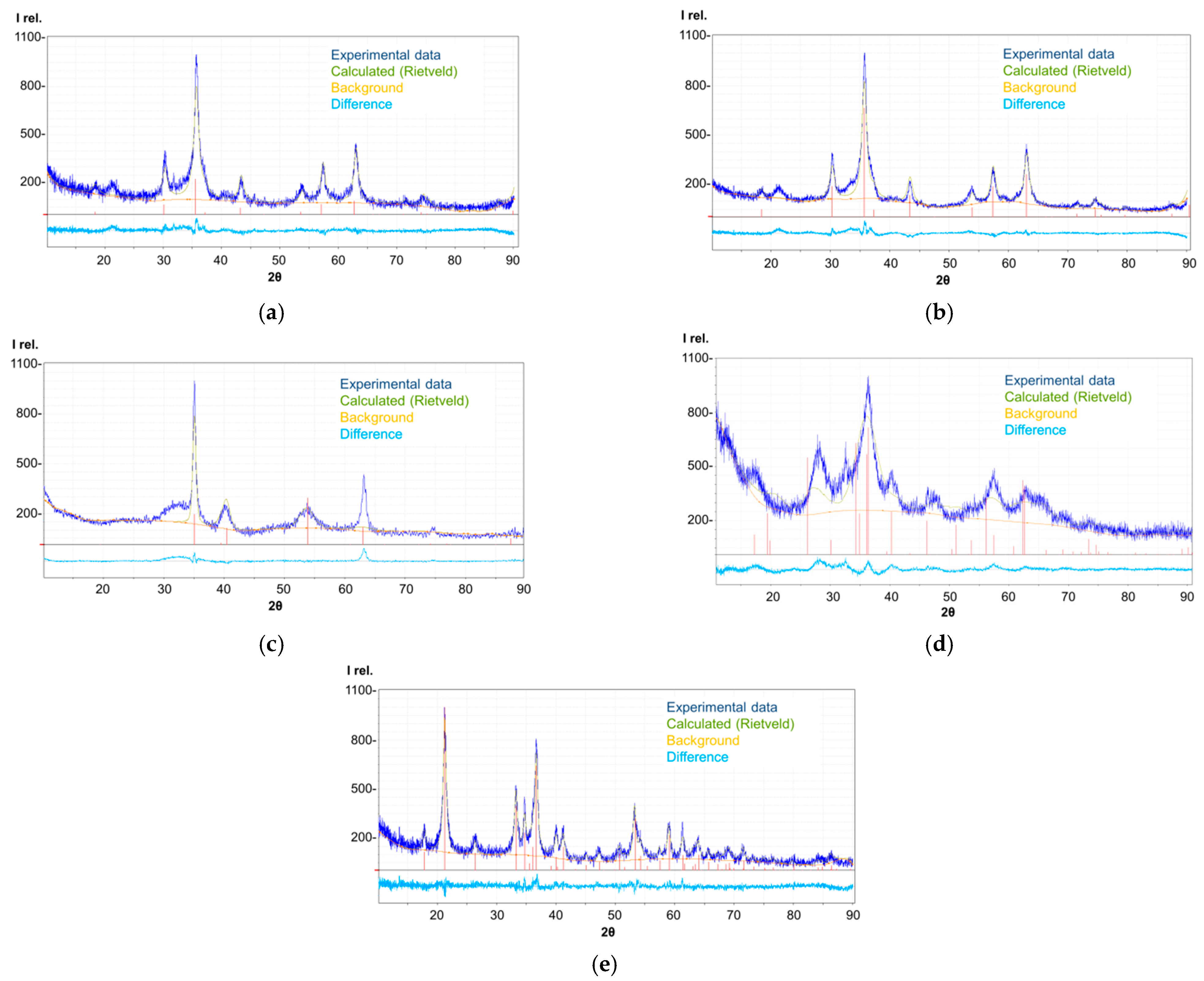
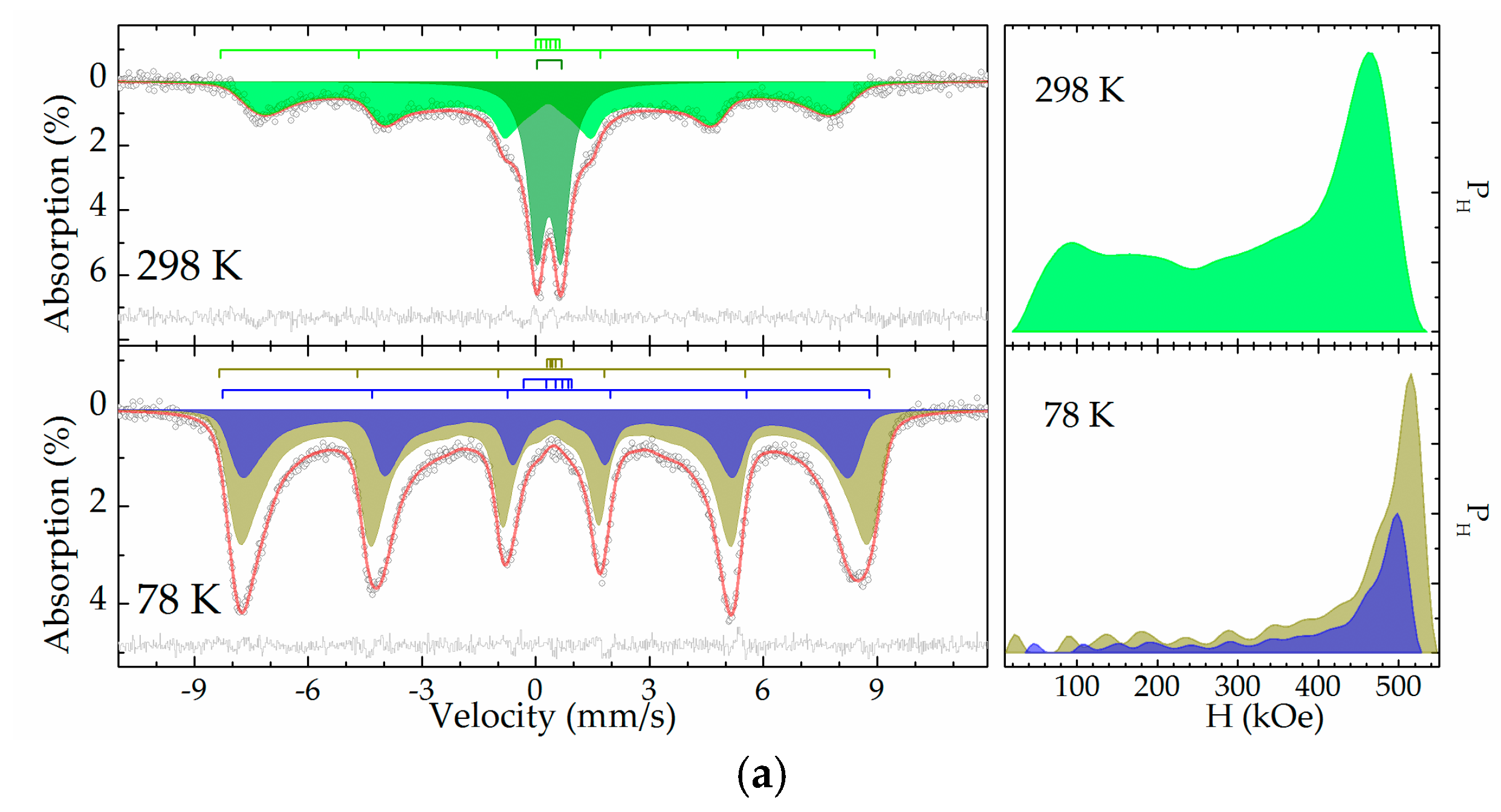
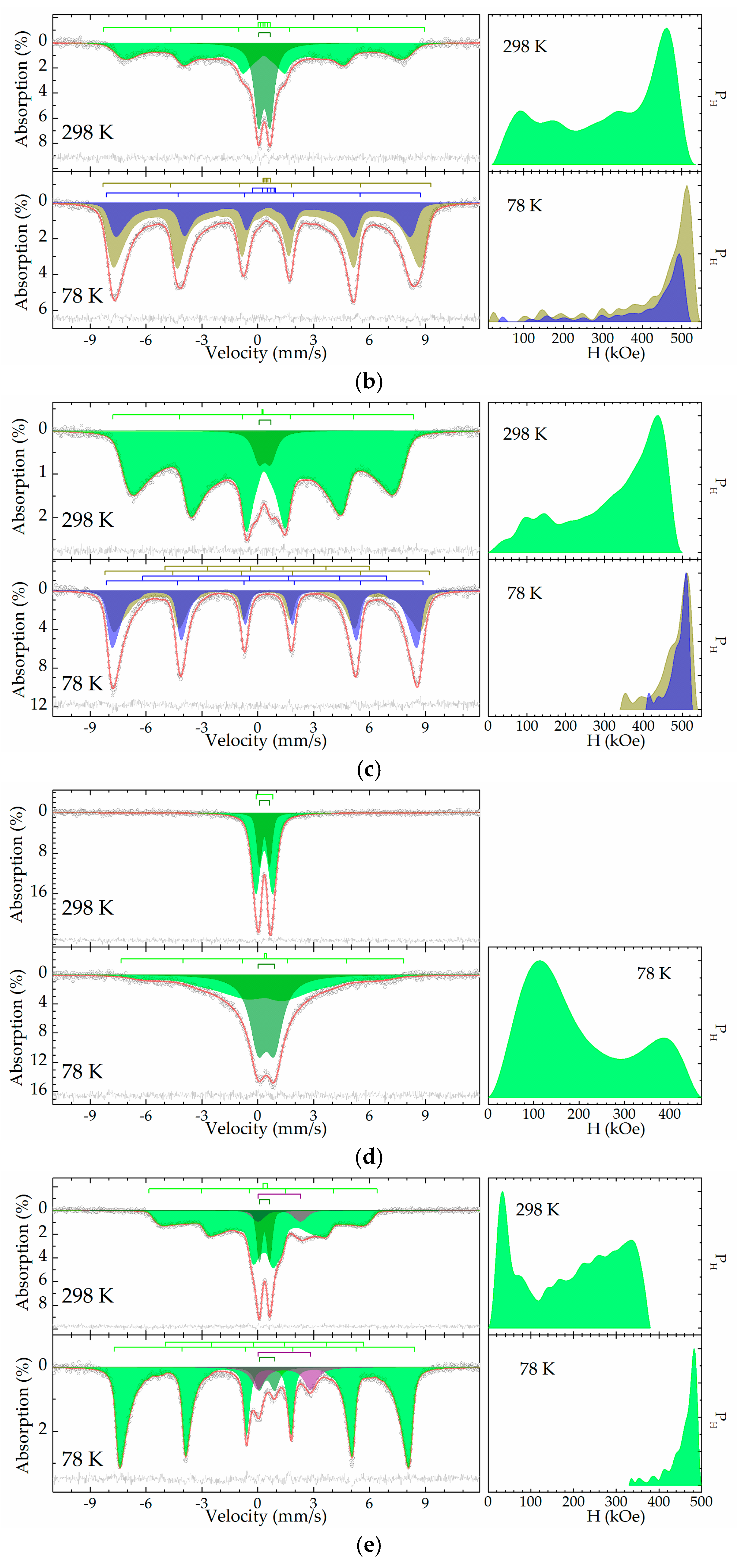
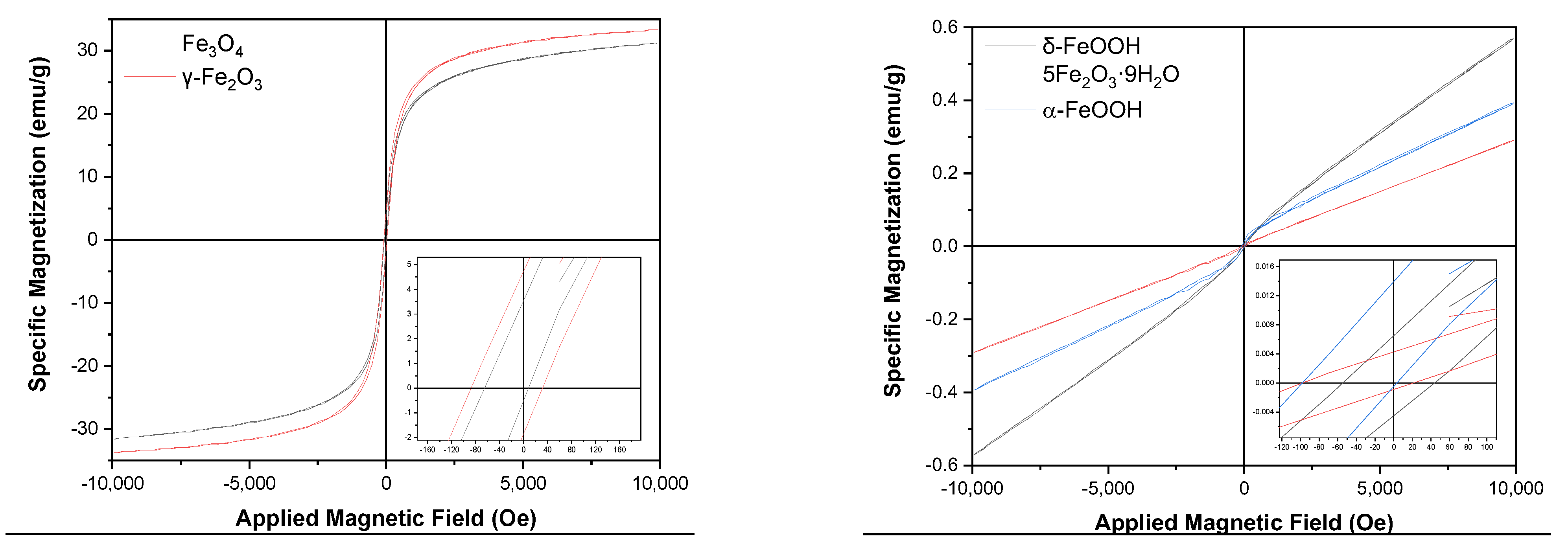
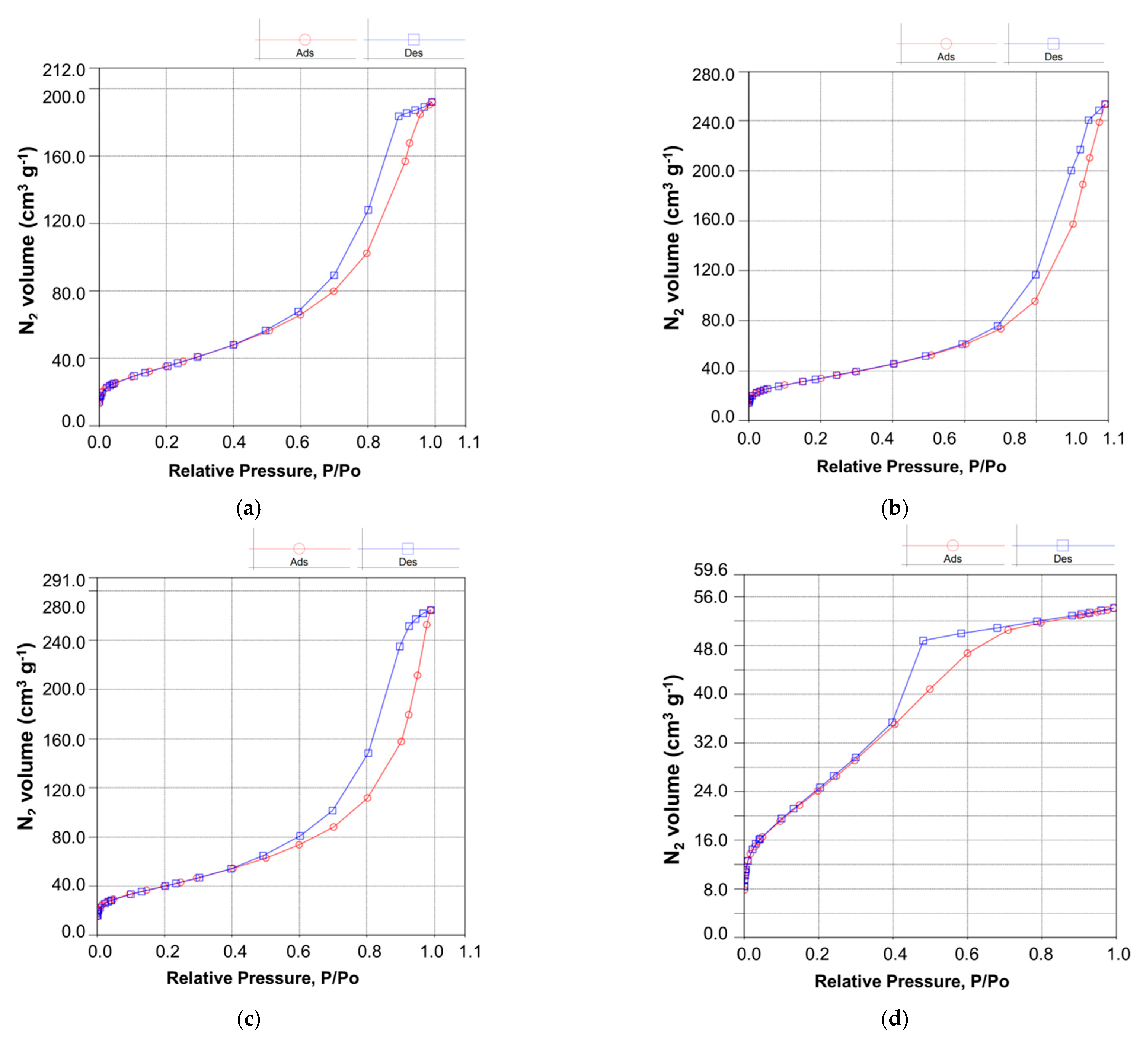
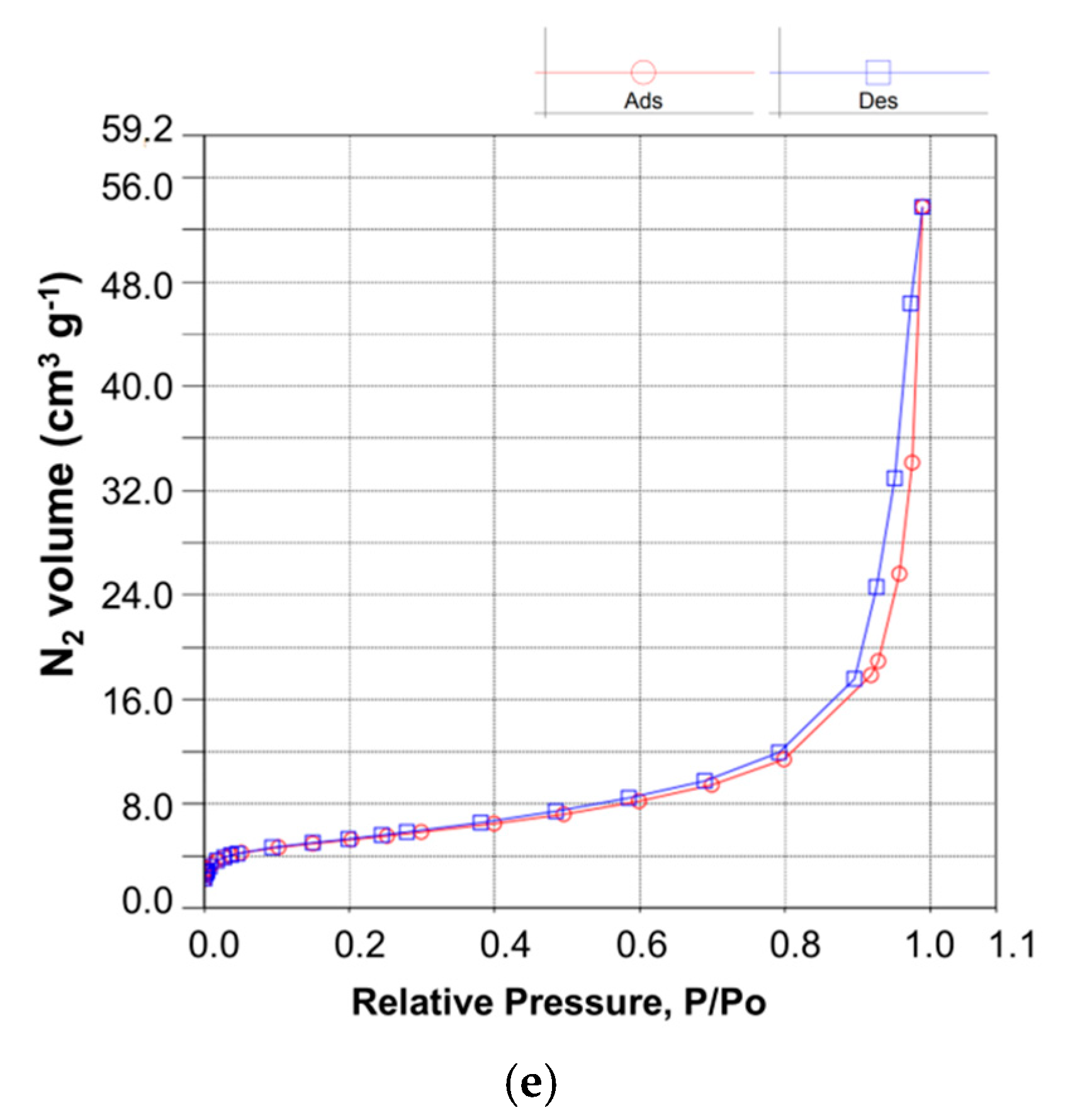
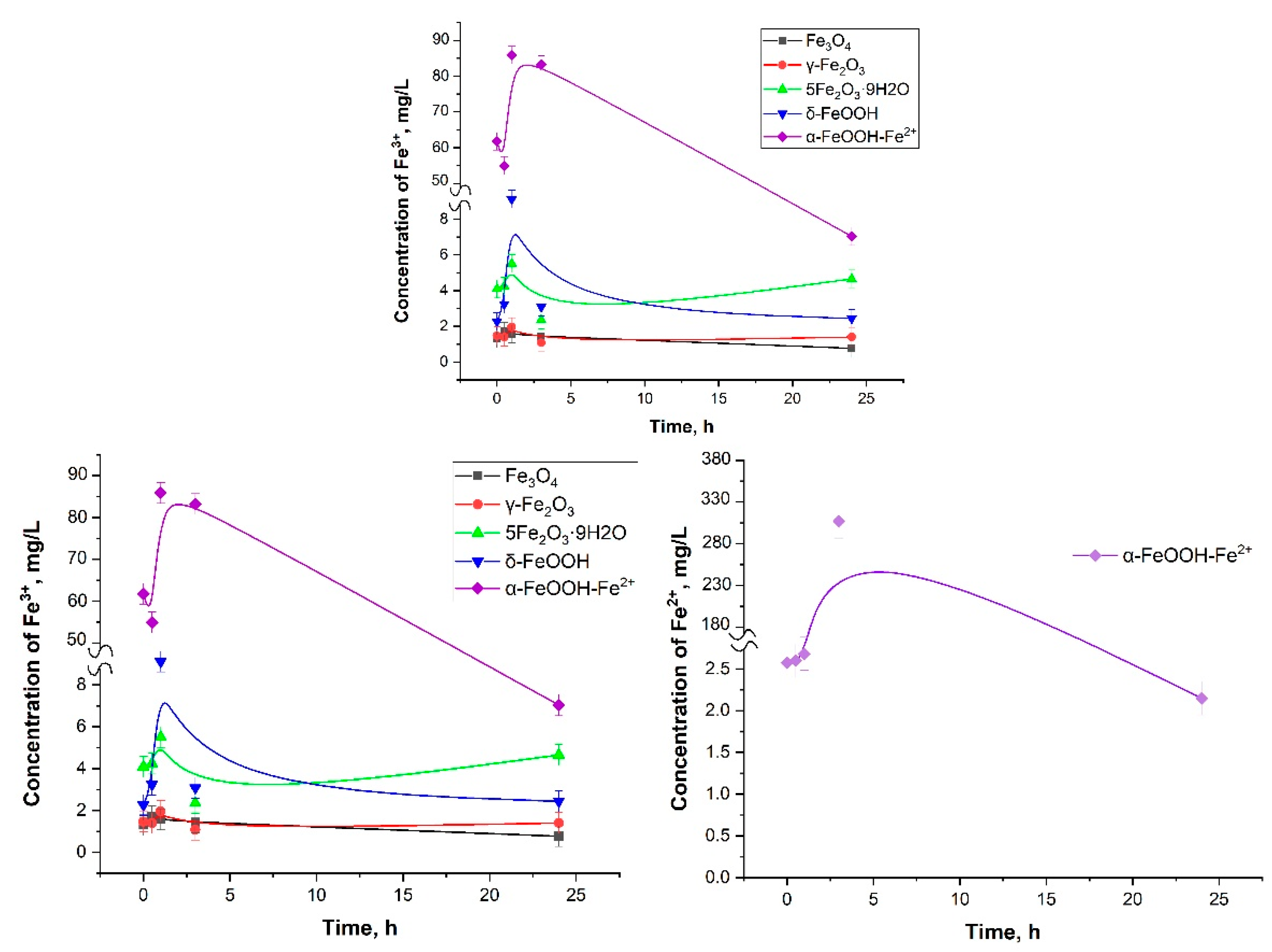
| Sample | Fe3O4 | γ-Fe2O3 | δ-FeOOH | 5Fe2O3·9H2O | α-FeOOH-Fe2+ |
|---|---|---|---|---|---|
| a, A | 8.331 | 8.344 | 2.951 | 5.961 | 4.609 |
| b, A | - | - | - | - | 9.965 |
| c, A | - | - | 4.586 | 8.499 | 3.022 |
| Structure | Fe2.66O4 | Fe2.56O4 | - | - | - |
| DXRD, nm | 6.6 ± 0.2 | 6.8 ± 0.2 | 8.1 ± 3.4 | 3.5 ± 0.5 | 12.3 ± 2.8 |
| (GoF)2 | 1.80 | 1.10 | 1.70 | 1.10 | 1.20 |
| Composition determined | Fe2.66O4 | Fe2.56O4 | δ-FeOOH | 5Fe2O3∙9H2O | α-FeOOH |
| Temperature, K | 296 | 78 | |||||||||
|---|---|---|---|---|---|---|---|---|---|---|---|
| Sample | # | δ (δext) 1 | Δ (Δext) | Γexp | Hext | S# | δ (δext) | Δ | Γexp | Hext | S# |
| mm/s | kOe | % | mm/s | kOe | % | ||||||
| Fe3O4 | 1 | 0.317 | −0.02 | 0.42 | 464 | 64.8 | 0.445 | 0.08 | 0.45 | 514 | 66.7 |
| 2 | 0.351 | 0.640 | 0.55 | - | 35.2 | 0.437 | −0.35 | 0.50 | 498 | 33.3 | |
| γ-Fe2O3 | 1 | 0.330 | 0.00 | 0.43 | 461 | 67.7 | 0.447 | 0.069 | 0.48 | 513 | 66.7 |
| 2 | 0.353 | 0.617 | 0.56 | - | 32.3 | 0.444 | −0.31 | 0.48 | 493 | 33.3 | |
| δ-FeOOH | 1 | (0.358) | (−0.162) | 0.48 | 437 | 94 | 0.489 | 0.02 | 0.46 | 512 | 50.0 |
| 2 | 0.38 | 0.64 | 0.75 | - | 6 | 0.479 | −0.24 | 0.42 | 510 | 50.0 | |
| 5Fe2O3·9H2O | 1 | 0.351 | 0.90 | 0.57 | - | 72 | (0.32) | −0.13 | 1.08 | 387 | 49 |
| (0.38) | 114 | ||||||||||
| 2 | 0.361 | 0.55 | 0.34 | - | 28 | 0.457 | 0.879 | 1.08 | - | 51 | |
| α-FeOOH-Fe2+ | 1 | 0.391 | −0.233 | 0.343 | 335 | 80.8 | 0.473 | −0.25 | 0.295 | 483 | 82.4 |
| 2 | 0.361 | 0.547 | 0.343 | - | 12.6 | 0.49 | 0.83 | 0.56 | - | 7.1 | |
| 3 | 1.16 | 2.28 | 0.82 | - | 6.6 | 1.42 | 2.81 | 0.82 | - | 10.5 | |
| Sample | Magnetization Saturation (Ms) | Residual Magnetization (Mr) | Coercive Power (Hc) |
|---|---|---|---|
| emu/g | emu/g | Oe | |
| Fe3O4 | 31.5 | 2.0 | 39.5 |
| γ-Fe2O3 | 33.5 | 3.28 | 59.0 |
| δ-FeOOH | 0.54 | 0.006 | 50.2 |
| 5Fe2O3·9H2O | 0.28 | 0.002 | 64.8 |
| α-FeOOH-Fe2+ | 0.41 | 0.007 | 50.1 |
| Sample | BET 1 | BJH 2 | ||
|---|---|---|---|---|
| SSA | Pore Volume | Pore Volume | Pore Diameter | |
| m2/g | cm3/g | cm3/g | nm | |
| Fe3O4 | 130.9 | 0.30 | 0.29 | 8.86 |
| γ-Fe2O3 | 123.0 | 0.39 | 0.39 | 8.71 |
| δ-FeOOH | 147.5 | 0.41 | 0.41 | 8.94 |
| 5Fe2O3·9H2O | 97.0 | 0.084 | 0.056 | 3.54 |
| α-FeOOH-Fe2+ | 18.8 | 0.083 | 0.080 | 23.8 |
Disclaimer/Publisher’s Note: The statements, opinions and data contained in all publications are solely those of the individual author(s) and contributor(s) and not of MDPI and/or the editor(s). MDPI and/or the editor(s) disclaim responsibility for any injury to people or property resulting from any ideas, methods, instructions or products referred to in the content. |
© 2022 by the authors. Licensee MDPI, Basel, Switzerland. This article is an open access article distributed under the terms and conditions of the Creative Commons Attribution (CC BY) license (https://creativecommons.org/licenses/by/4.0/).
Share and Cite
Dzeranov, A.; Bondarenko, L.; Pankratov, D.; Prokof‘ev, M.; Dzhardimalieva, G.; Jorobekova, S.; Tropskaya, N.; Telegina, L.; Kydralieva, K. Iron Oxides Nanoparticles as Components of Ferroptosis-Inducing Systems: Screening of Potential Candidates. Magnetochemistry 2023, 9, 3. https://doi.org/10.3390/magnetochemistry9010003
Dzeranov A, Bondarenko L, Pankratov D, Prokof‘ev M, Dzhardimalieva G, Jorobekova S, Tropskaya N, Telegina L, Kydralieva K. Iron Oxides Nanoparticles as Components of Ferroptosis-Inducing Systems: Screening of Potential Candidates. Magnetochemistry. 2023; 9(1):3. https://doi.org/10.3390/magnetochemistry9010003
Chicago/Turabian StyleDzeranov, Artur, Lyubov Bondarenko, Denis Pankratov, Mikhail Prokof‘ev, Gulzhian Dzhardimalieva, Sharipa Jorobekova, Nataliya Tropskaya, Ludmila Telegina, and Kamila Kydralieva. 2023. "Iron Oxides Nanoparticles as Components of Ferroptosis-Inducing Systems: Screening of Potential Candidates" Magnetochemistry 9, no. 1: 3. https://doi.org/10.3390/magnetochemistry9010003
APA StyleDzeranov, A., Bondarenko, L., Pankratov, D., Prokof‘ev, M., Dzhardimalieva, G., Jorobekova, S., Tropskaya, N., Telegina, L., & Kydralieva, K. (2023). Iron Oxides Nanoparticles as Components of Ferroptosis-Inducing Systems: Screening of Potential Candidates. Magnetochemistry, 9(1), 3. https://doi.org/10.3390/magnetochemistry9010003









